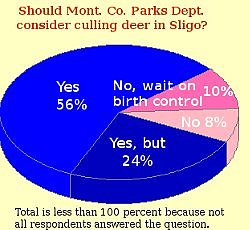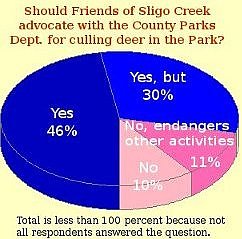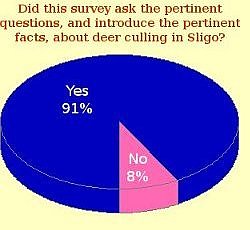Friends of Sligo Creek Deer Survey Report
EXECUTIVE SUMMARY
A total of 522 residents of the Sligo watershed responded to an on-line survey on deer management in November and December 2009. A significant majority (80 percent) felt that the county should engage in culling deer, either immediately (56 percent) or after informing and involving the wider community (24 percent). About the same number (76 percent) felt that Friends of Sligo Creek should advocate for deer culling in the Park, either immediately (46 percent) or after obtaining support from the affected neighborhood associations (30 percent). The majority of respondents (80 percent) came from the center of the watershed, between New Hampshire and Dennis Avenues. Three-fourths had some connection to Friends of Sligo Creek. About half reported deer damage to their gardens, but relatively few, fortunately, had direct experience with Lyme Disease or a deer-vehicle collision. More than half (57 percent) considered “biodiversity” a top priority for the Park. Evaluations of the survey were overwhelmingly positive (91 percent), but many thought better background could have been provided as to why the county will not consider chemical birth-control (or other alternatives) at this time.
DETAILED DISCUSSION
The deer survey was designed to assist the FOSC Board of Directors in deciding its next steps with regard to the issue of deer damage to vegetation and habitats in the Park. Because of the potentially divisive nature of this issue, the Board’s current position is to engage in education and research and not to take an advocacy position on any particular management option. This survey was part of the education and research effort. To read the current Deer Policy Statement of the board, click here. Full results of the survey, including written comments, follow this summary.
The survey structure and questions were modeled after those used in other urban and suburban jurisdictions that have coped with deer issues. Some of the sample surveys were found in a special 350-page issue of Wildlife Society Bulletin (vol. 25, no. 2, 1997) devoted to management of over-abundant deer populations. Since our survey was directed at watershed residents with some connection to Friends of Sligo Creek, no attempt was made to reach a random sample of the entire watershed population, which the Council of Governments recently estimated at 81,943 in Montgomery County, Prince George’s County, and Washington, DC. You can browse the Anacostia Watershed site here. Our survey was posted for six weeks on the Friends of Sligo Creek website. Additionally, it was advertised through two issues of the FOSC monthly e-newsletter (779 subscribers), two reminders to that list, announcements at FOSC events, and through efforts by FOSC members to promote the survey to their neighborhood associations. The FOSC webmaster monitored responses in order to detect repeated entries from identical sources and prevent “ballot stuffing.”
The Friends of Sligo Creek has posted the survey results and this report on its website and is spreading the word about it to the FOSC membership through its monthly e-newsletter. The FOSC Board will share the results with the Montgomery County Parks Department and meet with their staff to continue our discussions with them about deer issues in general. The survey results will serve as a crucial aid in helping the board decide on future steps to take regarding the deer issue.
 The bulk of respondents live in the center sections of the watershed, with 82 percent residing between New Hampshire and Dennis Avenues. Only six percent came from north of University Blvd. and four percent from below New Hampshire. See map to the right. One third (33 percent) live between Colesville and Dennis. Fully three-fourths of respondents spend time in the Park at least once a week. Nearly 60 percent walk, jog, or run in the park “often.” On their connections to Friends of Sligo Creek, about a fourth of respondents (27 percent) have no connection to FOSC. Of the rest, one out of five (21 percent) have participated in our annual Sweep the Creek clean-up events. Almost 40 percent of respondents have lived in the watershed for ten years or less, while 32 per cent have resided here more than 20 years.
The bulk of respondents live in the center sections of the watershed, with 82 percent residing between New Hampshire and Dennis Avenues. Only six percent came from north of University Blvd. and four percent from below New Hampshire. See map to the right. One third (33 percent) live between Colesville and Dennis. Fully three-fourths of respondents spend time in the Park at least once a week. Nearly 60 percent walk, jog, or run in the park “often.” On their connections to Friends of Sligo Creek, about a fourth of respondents (27 percent) have no connection to FOSC. Of the rest, one out of five (21 percent) have participated in our annual Sweep the Creek clean-up events. Almost 40 percent of respondents have lived in the watershed for ten years or less, while 32 per cent have resided here more than 20 years.
Five survey questions asked about residents’ experience of deer problems. About one-half (45 percent) reported deer damage to their gardens. Virtually an equal number reported reported no recent change in damage (31 percent) as indicated a recent increase in damage (29 percent). Twenty-three individuals had contracted Lyme Disease (four percent of respondents), though not necessarily in Sligo, and another 159 (30 percent) knew someone else who had the disease. Thirty-one respondents (six percent) had experienced a deer-vehicle collision. A surprisingly high number (39 percent) reported seeing a dead deer in the Park. Nearly a third of respondents (32 percent) reported following the deer management issue “very closely,” with another 43 percent having “read an article or two on the subject.” In all, three-fourths thought there were too many deer in the Park, including 54 percent who felt there were “way too many” and 21 percent felt there were “a few too many.” Sixteen percent felt the number was about right (12 percent) or wish we had more (four percent).
As to the place of natural habitat in the range of priorities for the Park, well over half of respondents (57 percent) indicated that “preserving biodiversity is a top priority for me.” Another 30 percent said that biodiversity was on an equal footing with sports and recreation.

As to what steps the county should take with regard to deer in Sligo, fully 80 percent felt that the county should cull deer immediately (56 percent) or after taking steps “to better inform and involve the wider Sligo community in presenting the problem and possible solutions” (24 percent). See pie chart to the left. Ten percent said the county should wait to see if more effective birth control measures are developed. Eight percent indicated that the county should not consider killing deer in Sligo. Sixty percent were “more inclined to support deer culling knowing that the meat is donated” to local food banks, but 38 percent said this fact had no bearing on their opinion. As for the safety of culling deer with police sharpshooters, 60 percent reported having “no concerns,” while 29 percent indicated there would be “some risk to public safety.”
 On the crucial question of what role Friends of Sligo Creek should play in this difficult issue, more than three-fourths of respondents indicated that FOSC should advocate for deer culling with the county, either immediately (46 percent) or after obtaining “clear support from neighborhood associations” (30 percent). See pie chart to the right. About ten percent felt that other activities of FOSC would suffer if the organization took a public stand in favor of culling, and another ten percent felt that FOSC “has no place in advocating for the killing of deer in Sligo.” Where respondents lived and whether they were connected to FOSC had little impact on their opinion. Virtually equal numbers of respondents living north of Colesville Rd. (73 percent) and south of Colesville (75 percent) approved of FOSC taking a pro-culling position with the County, either immediately or with the support of neighborhood associations. Those with no connection to FOSC were almost as likely to take this position (70 percent) as those with a connection to FOSC (73 percent).
On the crucial question of what role Friends of Sligo Creek should play in this difficult issue, more than three-fourths of respondents indicated that FOSC should advocate for deer culling with the county, either immediately (46 percent) or after obtaining “clear support from neighborhood associations” (30 percent). See pie chart to the right. About ten percent felt that other activities of FOSC would suffer if the organization took a public stand in favor of culling, and another ten percent felt that FOSC “has no place in advocating for the killing of deer in Sligo.” Where respondents lived and whether they were connected to FOSC had little impact on their opinion. Virtually equal numbers of respondents living north of Colesville Rd. (73 percent) and south of Colesville (75 percent) approved of FOSC taking a pro-culling position with the County, either immediately or with the support of neighborhood associations. Those with no connection to FOSC were almost as likely to take this position (70 percent) as those with a connection to FOSC (73 percent).
SURVEY EVALUATION
A vast majority of respondents (91 percent) indicated that the survey “asked the pertinent questions, and introduced the pertinent facts, about deer culling n Sligo.” Eight percent of respondents felt that it did not. See pie chart to the left.
In the sections for written comments, a frequent complaint was that insufficient space was devoted to alternatives to culling, especially chemical birth-control. The survey authors agree that it should have explained that the county continues to “monitor progress in the use of contraception to regulate deer populations,” including the “on-going efforts at the National Institute of Standards and Technology being conducted by the Humane Society of the U. S., as well as other study sites around the country.” In the meantime, however, “contraception, while favored by many as a potential method to reduce deer numbers, is still very much in the experimental stages and not available for use in free ranging deer at this time (Montgomery County Deer Management Program, Annual Report and Recommendations FY 2009, linked below).
The survey authors felt that, since other alternatives to culling have also been rejected by the county, there was no point in asking residents their opinions about these methods, including re-introduced predators, capture-and-relocate, surgical sterilization, managed hunts (approved for rural parks only), fencing, and chemical deterrents. A detailed discussion of the pros and cons of all these approaches can be found in An Evaluation of Deer Management Options, Northeast Deer Technical Committee, 2008, linked below. See also Comprehensive Management Plan for White-tailed Deer in Montgomery County, Montgomery County Deer Management Work Group, 1995 (revised 2007), linked below.
A few respondents felt that more attention should been given to the threat of Lyme Disease, which can become chronic and debilitating. The county’s Deer Management Program points out that “reducing deer numbers cannot effectively control the spread of the disease [since] black-legged ticks . . . most often pick up the disease by feeding on infected mice and chipmunks not deer” (Montgomery County Deer Management Program, Annual Report and Recommendations FY 2009), linked below.
Comprehensive Management Plan for White-tailed Deer in Montgomery County
Northeast Deer Technical Committee, An Evaluation of Deer Management Options, 2008
Montgomery County Deer Management Program, Annual Report and Recommendations FY2009
CREDITS
The Board of the Friends of Sligo Creek thanks its webmaster, Clair Garman, for creating an on-line site for the survey, for collating the results, and calculating insightful correlations. He also monitored the sources of responses, in order to detect “ballot-stuffing” or other fraud, which was not found. The Board thanks those who reviewed the survey in advance, and especially thanks the more than 500 watershed residents who took the time and trouble to complete the survey. The results will be invaluable in guiding the Board toward its next steps in dealing with this difficult and urgent issue.
March 2010
SURVEY RESULTS
View written comments to questions 11, 12, 14, 15, and 16.
1. How long have you lived near Sligo Creek Park?
[103 – 20%] – 5 years or less[101 – 19%] – 6-10 years[83 – 16%] – 11-15 years[57 – 11%] – 16-20 years[166 – 32%] – more than 20 years
2. Where in the Sligo Creek (or Long Branch) area do you live?
[21 – 4%] – East-West Highway and New Hampshire Ave.[47 – 10%] – New Hampshire Ave. and Maple Ave.[91 – 19%] – Maple Ave. and Piney Branch Rd.[47 – 10%] – Piney Branch Rd. and Wayne Ave.[49 – 10%] – Wayne Ave. and Colesville Rd.[74 – 16%] – Colesville Rd. and Forest Glen Rd.[78 – 17%] – Forest Glen Rd. and Dennis Ave.[31 – 6%] – Dennis Ave. and University Blvd.[31 – 6%] – University Blvd. and Arcola Ave.[22 – 4%] – Near Long Branch, between Sligo Parkway and Carroll Ave.[14 – 3%] – Near Long Branch, north of Carroll Ave.
3. What kinds of activities do you do in the Park?
Walking – [302 – often] [163 – occasionally] [33 – rarely] Cycling – [78 – often] [170 – occasionally] [104 – rarely] Jogging or running – [279 – often] Playing or practicing sports – [19 – often] [57 – occasionally] [159 – rarely] Having picnics – [9 – often] [78 – occasionally] [169 – rarely] Playing with children – [95 – often] [104 – occasionally] [100 – rarely] Taking photographs – [28 – often] [126 – occasionally] [129 – rarely] Observing or monitoring nature – [156 – often] [143 – occasionally] [56 – rarely] Pulling alien, invasive plants – [28 – often] [109 – occasionally] [157 – rarely] Cleaning the Park of trash – [48 – often] [170 – occasionally] [114 – rarely]
4. On average, how often do you spend time in the Park?
[156 – 30%] – About every day[225 – 44%] – About once a week[76 – 15%] – About once a month[35 – 6%] – About once every few months[9 – 1%] – About once a year[5 – 0%] – Less than once a year
5. Are you connected in some way with Friends of Sligo Creek?
[207 – 27%] – No[212 – 27%] – Read the monthly e-newsletter[51 – 6%] – Read and contribute to the list-serv[166 – 21%] – Participate in clean-up events[47 – 6%] – Attend program meetings or nature outings[27 – 3%] – Post items on the “Sightings” page of plants or animals seen[39 – 5%] – Am a current or former member of a committee or now serve, or have served, another function for the Friends[12 – 1%] – Am a current or former member of the Board of Directors
6. What is your sense about the number of deer currently using Sligo Creek Park?
[276 – 54%] – Way too many[107 – 21%] – A few too many[62 – 12%] – About the right number[25 – 4%] – I wish we had more[36 – 7%] – No opinion, or do not know
7. Have you, or anyone you know, had direct experience of any of these kinds of deer damage?
vehicle collision – [31 – Self] [116 – Other] Lyme disease – [23 – Self] [159 – Other] bitten by deer tick – [70 – Self] [128 – Other] damage to garden or landscape plants – [234 – Self] [178 – Other] significant loss of wildflowers, shrubs, or small trees in nearby Park land – [168 – Self] [118 – Other]
8. Have you ever seen any of the following?
[205] – A dead deer in the Park[367] – Deer in your yard or around your apartment property[66] – Deer trapped in highway clover-leaf[261] – A herd of six or more deer in the Park
9. Have you noticed an increase in damage to your garden or landscape plants in the recent years?
[171 – 29%] – Yes, I have noticed a significant increase[62 – 10%] – Yes, but only a slight increase[186 – 31%] – No, no change[12 – 2%] – No, in fact it has decreased[69 – 11%] – No opinion[82] – I have installed I have installed (or my apartment complex has installed) tall fencing or other deterrents.
10. Have you read about problems associated with deer populations in the New York Times, Washington Post, Silver Spring/Takoma Gazette, web sites, community list-servs, or other media?
[187 – 32%] – Yes, I follow the issue very closely[251 – 43%] – Yes, I’ve read an article or two on the subject[27 – 4%] – No, I’ve noticed the headlines or subject lines, but not read further[40 – 6%] – No, I am not aware of media coverage of this issue.
11. How important to you is preserving a rich diversity of plants in Sligo Creek Park, enabling tree saplings to survive and replace our aging trees, and providing habitat for animals such as nesting birds?
[282 – 57%] – Preserving biodiversity is a top priority for me.[149 – 30%] – Biodiversity is important for Sligo, but no more so than opportunities for sports, recreation, picnicking, and driving along the Parkway.[58 – 11%] – Deer are part of biodiversity and their numbers should be allowed to grow without human interference.[4 – 0%] – The Park is primarily a place for humans, and so biodiversity is a low priority for me.
12. With this in mind, do you think the Montgomery County Parks Dept. should consider culling deer in Sligo, in order to prevent further damage to Sligo’s natural resources?
[276 – 56%] – Yes, I believe the County should immediately institute culling of deer in Sligo in order to prevent further damage to our woodlands.[121 – 24%] – Yes, but I believe the County must first take steps to better inform and involve the wider Sligo community in presenting the problem and possible solutions.[50 – 10%] – No, I believe the County should wait to see if more effective birth control techniques might be developed for use in suburban parks, even if it means a long period of further damage to plant and animal life in the Park.[50 – 8%] – No, the County should not consider killing deer in Sligo.
13. If you indicated “no” or “not sure” to the above question, would it make a difference knowing that all deer meat harvested through the County’s sharpshooter operations is donated to food banks in Maryland, and that these food banks express considerable gratitude in receiving protein-rich meat that is otherwise hard for food banks to come by?
[139 – 61%] – Yes, I am more inclined to support deer culling knowing that the meat is donated to needy charities.[87 – 38%] – No, my opposition to deer culling is not effected by the County’s practice of donating harvested meat to food banks.
14. Do you have safety concerns about deer culling with sharpshooters in Sligo Creek Park?
[297 – 60%] – I have no concerns[148 – 29%] – I am concerned that, despite the track record, there would be some risk to public safety.[50 – 10%] – I object to the killing of animals no matter how it is done.
15. Do you believe that the Friends of Sligo Creek should lobby the County to pursue culling of deer in the Park?
[226 – 46%] – Yes, I believe it is FOSC’s duty as a steward of the Park’s natural habitats to independently advocate with the County for a culling program to begin as soon as possible.[150 – 30%] – Yes, but not without the clear support of the neighborhood associations that border the Park nearest to where the culling would take place.[57 – 11%] – No, I believe that the other activities of FOSC are too valuable to allow them to be undermined by controversy if it advocated for deer culling.[53 – 10%] – No, I believe that FOSC has no place in advocating for the killing of deer in the Park.
16. Did this survey ask the pertinent questions, and introduce the pertinent facts, about deer culling in Sligo?
[443 – 91%] – Yes[41 – 8%] – No



